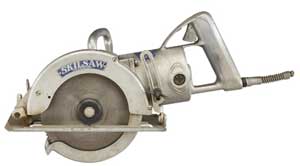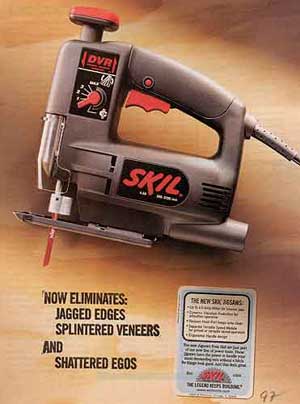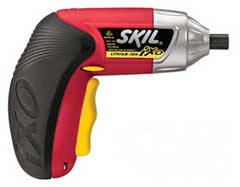
When I first got into woodworking, I was taught the names of tools, like chisels, planes, band saws and the like. But if you showed me what we now call a portable circular saw, I would have quickly identified it as a “Skilsaw.” That’s what everyone called it, and there’s good reason for that. Skil not only invented that incredibly handy tool, but also went on to develop a whole host of improvements to it and a wealth of its brethren.
“Skilsaw has long been the industry term for a circular saw,” agreed Gregg Mangialardy, a group product manager who has been with the company for 33 years. “Skil invented the circular saw and holds the original patent issued in 1921. The name Skil was trademarked on Nov. 26, 1924. Skil is the company name, but we still use the name Skilsaw for our circular saw.”
“The Skilsaw actually played an instrumental role in creating housing in America,” added Sean Tegart, the Director of Marketing. “The story goes that early prototypes of the tool were tested in the booming construction industry in California in 1924. Contractors were immediately enthralled with the idea of taking the tool to the work instead of the other way around. It really revolutionized the way they built. In those days, Skil was competing with hand saws, since we were the only portable circular saw in the market. What Skil introduced was not just a new tool, but a whole new method of work.”
Like most great inventions, it didn’t start out quite the way it looks today, nor was it originally geared toward woodworkers. “Edmund Michel developed a power machete in 1921,” explained Gregg, “while he was in Louisiana watching people cut sugar cane. He noticed that it took multiple cuts with a machete due to the fibrous nature of the cane. He put a small, two-inch circular blade at the end of the machete and a motor, connected with a worm gear, on the handle. That allowed cane to be chopped in a single cut. It had some problems, and cane cutters were not impressed. For one thing, getting electricity to the middle of a sugar cane field was a challenge, since generators were not small and portable in those days, but another individual was to enter the story.”
“A man named Joseph Sullivan was on a train,” continued Sean, “and read an article about Edmund Michel’s innovation. He was so intrigued that he diverted his trip to meet with Michel. He suggested if Michel could make the tool a bit more robust, it would be great for the construction industry. By their second meeting, Michel had a wooden handled worm drive version that powered a six-inch blade. By 1924 they came together as a formal company called the Michel Electric Handsaw Company.
“They tested their prototypes with construction workers, and even though the tools wore out in a day or two, contractors and builders were so impressed with what they were able to get done quickly that they still wanted them. After all, it was the first portable device, and there was no history for making tools to withstand the rigors of on-site building. What followed was the Model E, which had a die-cast aluminum housing. This time the motor was integrated into the tool instead of hung inside a wooden handle. The aluminum provided the strength and security needed, and it became a quick success. Much later, we created the Mag 77, a saw with a magnesium housing that allowed us to reduce the saw weight by about two pounds.
“For a long time, Skil was the only company making such a tool, which explains why the name Skilsaw became synonymous with it. Common folklore insists that because we tested the initial models on the West coast, workers in that area still prefer a worm drive saw. Though we make both worm drive and direct drive ‘sidewinder’ versions today, there is a significant geographic split between sales of the two types on the East and West coasts.”
“When the first DIY movement started after the war,” Gregg went on, “we added more products, like drills and other portable tools, and separated the word Skil for the rest of the line. In the late ’40s, we added gardening tools, like hedge trimmers and chain saws. In fact, a Skil chainsaw was used in the original Texas Chainsaw Massacre movie.
“Over the years, we’ve continued to develop innovations that allow us to boast of many firsts. We introduced the Varied Torque clutch, designed to help minimize kickback, in 1949; the first three-way action Roto Hammer in 1960; trigger speed control in 1964; a vibration insulated handle and auto-brake for the chainsaw in 1977; the first in-line battery powered screwdriver in 1985; on-tool wrench storage in 1986; an auto track mechanism for belt sanders in 1992; a scrolling jigsaw with orbital action in 1997; and an anti-snag lower guard on the Skilsaw in 2003.
“Today, Skil is a company based on Sullivan’s original vision: you don’t build a product to sell, you build it to perform. Sullivan said: ‘If you build a product to sell, you will keep it; if you build it to perform, you will sell it.’ These days there is tremendous pressure in our industry to do value engineering. Companies use research to figure out how long or heavily the average user will work a tool, then design a product that is only good enough for that. We don’t do that. We build products that will perform each time regardless of the level of challenge. Because of that, Skil is favored by DIYers and pros alike and is sold to both. You’ll see the same Skil tools in homeowners’ garages and on construction jobsites, and that’s saying a lot. Construction workers are very sensitive to peer pressure and don’t want to walk onto a jobsite with a tool that will generate derision. Skil has credibility across the board with them.
“Our current line is based around project success. When a project goes well, craftsmen take credit, but when it goes poorly, they blame it on the tool. Our goal is to prevent things from going wrong. For instance, we developed cordless tools with lights because we found people were using them in closets and dark areas. Lit arrows pointing to forward or reverse let you know which direction a drill bit will go, an innovation that helps occasional users avoid skittering the bit across a surface. We added a dual beam laser to the front of our circular saw and jigsaw to help you keep the saw on track. For those that only make a few cuts of year, this is invaluable.
“This past year, we introduced a pressure control on our palm sanders that alerts you if you are applying too much pressure to get the proper finish, which is a very common problem. We were the first to introduce the cordless screwdriver, but also introduced lithium-ion tools in 2003 with the iXO cordless screwdriver, which has sold over 8 million units worldwide. We were the first to incorporate a sight light in our router that illuminates the bit as it cuts. The light goes on automatically when you wrap your hand around the handle.
“Some innovations go well beyond the norm. Many chop saws now have lasers to indicate the cut, but we did something different. Our miter saw has a motion sensor on the laser that goes on when you approach the saw. That lets you set up the cut long before you turn on the saw or even touch the handle. That’s not just a solution to a problem; it is THE solution to the problem. Things like that make the difference between a successful result and a tool taking the blame.
“Last year we introduced the Skil Power Cutter, a multi-material powered cutting wheel that some people call the world’s smallest Skilsaw. We’re told that what people like best about it is how it cuts through those annoying clamshell packages that are otherwise nearly impossible to open.
“Wander the Skil website and you will find about 80 items, including sanders, routers, drills, saws, benches, and grinders. There’s even a separate website for our bench top tools, like contractors’ table saws, chop saws, drill presses, stationary sanders, scroll saws and band saws. Our number one retailer, Lowe’s®, carries 44 different Skil tools. We also sell through Home Depot, Costco, Wal-Mart and others, but Lowe’s is our dominant partner and you are likely to find more Skil tools there. Lowe’s seems interested in selling a project rather than merely a tool. As a result, they get a lot of our marketing support and many of our product launches.
“For those of you who have not used a Skil tool lately, you should definitely give us a try again. Admittedly, there was a period of time in the early ’90s that we got a bit stale with our brand, and to a certain extent, lost some of our luster. That’s turned around. When we do demos at retailers, the feedback we get is so positive, that today, I would challenge anyone to try one of our tools and not be very impressed.
“What Skil means to people is success. They know that when they have a project and they use a Skil tool, they will achieve the success that they want. That’s why our tag line, ‘Do it right. Do it with Skil.’ is as fitting as it is clever. It’s all about project success.”














